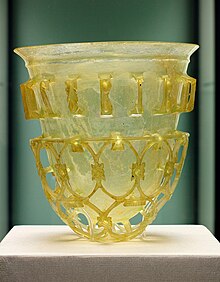History of glass

The history of glass-making dates back to at least 3,600 years ago in Mesopotamia, however some claim they may have been producing copies of glass objects from Egypt.[1] Other archaeological evidence suggests that the first true glass was made in coastal north Syria, Mesopotamia or Egypt.[2] The earliest known glass objects, of the mid 2,000 BC, were beads, perhaps initially created as the accidental by-products of metal-working (slags) or during the production of faience, a pre-glass vitreous material made by a process similar to glazing.[n 1] Glass products remained a luxury until the disasters that overtook the late Bronze Age civilizations seemingly brought glass-making to a halt.
Development of glass technology in India may have begun in 1,730 BC.[3] In Ancient China glass-making had a later start compared to ceramics and metal work.
From across the former Roman Empire archaeologists have recovered glass objects that were used in domestic, industrial and funerary contexts. Anglo-Saxon glass has been found across England during archaeological excavations of both settlement and cemetery sites. Glass in the Anglo-Saxon period was used in the manufacture of a range of objects including vessels, beads, windows, and was even used in jewelry.
Origins[]

Naturally occurring glass, especially the volcanic glass obsidian, has been used by many Stone Age societies across the globe for the production of sharp cutting tools and, due to its limited source areas, was extensively traded. But in general, archaeological evidence suggests that the first true glass was made in coastal north Syria, Mesopotamia or ancient Egypt.[2] Because of Egypt's favorable environment for preservation, the majority of well-studied early glass is found there, although some of this is likely to have been imported. The earliest known glass objects, of the mid-third millennium BC, were beads, perhaps initially created as accidental by-products of metal-working (slags) or during the production of faience, a pre-glass vitreous material made by a process similar to glazing.[n 1]
During the Late Bronze Age in Egypt (e.g., the Ahhotep "Treasure") and Western Asia (e.g., Megiddo),[4] there was a rapid growth in glassmaking technology. Archaeological finds from this period include colored glass ingots, vessels (often colored and shaped in imitation of highly prized hardstone carvings in semi-precious stones) and the ubiquitous beads. The alkali of Syrian and Egyptian glass was soda ash (sodium carbonate), which can be extracted from the ashes of many plants, notably halophile seashore plants like saltwort. The latest vessels were 'core-formed', produced by winding a ductile rope of glass around a shaped core of sand and clay over a metal rod, then fusing it by reheating it several times.[citation needed]
Threads of thin glass of different colors made with admixtures of oxides were subsequently wound around these to create patterns, which could be drawn into festoons by using metal raking tools. The vessel would then be rolled smooth (marvered) on a slab in order to press the decorative threads into its body. Handles and feet were applied separately. The rod was subsequently allowed to cool as the glass slowly annealed and was eventually removed from the center of the vessel, after which the core material was scraped out. Glass shapes for inlays were also often created in moulds. Much of early glass production, however, relied on grinding techniques borrowed from stone working. This meant that the glass was ground and carved in a cold state.[5]
By the 15th century BC, extensive glass production was occurring in Western Asia, Crete, and Egypt; and the Mycenaean Greek term
